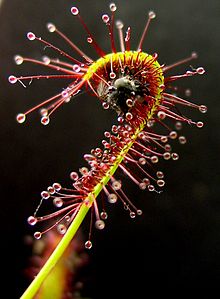Tip of the Week – Focus on Carnivorous Plants
Carnivorous Plants
Carnivorous Plants are fascinating to watch in action as they capture their insect food. Not only unusual they are also amazing to look at with surprising bright flowers and ornate colour structures.
Botanically speaking there are some 650 species of carnivorous plants spread over 12 Genus. The ones we deal with are in the Genus of Nepenthes, Sarracenia and Drosera.
Prey & Trapping Mechanisms
They eat insects and other arthropods and have even been known to devour frogs and small mammals. Some like the Sundews use sticky substances to trap their prey together with rapid leaf movement and growth. Some use leaf foldover. Some like the Sarracenia Pitcher Plants slide down a one way tube & drown before digestion and some like the Nepenthes get imprisoned behind a trapdoor & then dissolved in a digestive juice. Some have a touch sensitive leaf by using trigger hairs. All have an attraction device.
Multiplication
Sarracenias & Drosera Sundews can be multiplied by division. Nepenthes can be multiplied by cuttings. The three can be multiplied by seed gathered from the flowers.
Flowering
They will all give you surprising flowers in many colours.
Carnivourous Plant Care
Sarracenia Pitcher Plants and Sundews are bog plants so you can sit them in water.They can grow in cold conditions and like plenty of sunlight.
Nepenthes are more tropical and like to hang or climb. They like warm humid coastal conditions and require filtered light.
All Carnivorous Plants get their nutrients from their prey but a little fertiliser may not go astray but do not overdo it as they are adapted to low nutrient conditions and thats why through the evolutionary process they adapted to catching their own nutrient. Excess nitrogen could be deadly for them.
Enemies
Powdery Mildew, Mealy Bug and Aphids can be a problem but we have not ever found this to be the case. Manual removal or insecticides will get rid of them. With the first two you should repot and change the conditions the plant is growing under as its a sure sign the plant is not happy where it is.
Potting Mix
Use a well drained potting mix that will still hold moisture without saturation. Coco peat & sphagnum moss mixes are fine.


